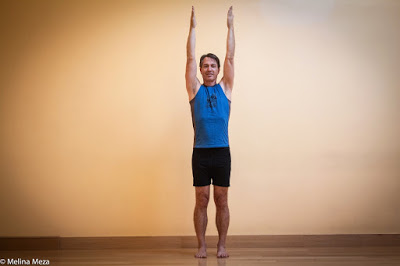
Q: I have been enjoying the videos of mini vinyasas that you
all have been sharing on Mondays. However, I notice that you give very specific
and consistent instructions on how to move with the breath, even though sometimes
I’d prefer doing the opposite. Are there any rules or reasons why you recommend
them the way you do?
A: This is one of the most common questions I get from
students who have never worked with mini vinyasas or dynamic poses before. I
was first exposed to these practices when I traveled to India in 2005 to study
with TKV Desikachar and his staff of amazing teachers. It was there that I was
first exposed—other than doing Cat-Cow pose in my classes back home—dynamic
versions of many of the poses I had been holding statically in my Iyengar-style
of practice.
In this tradition, in dynamic poses, there is a starting
position from which you move into the full pose and then back again, repeating
the process six or more times. And there is always a suggested pattern to the
breath, which works best with the effect of the pose on the abdomen and the
flow of breath. Here is the basic gist:
- When moving into a backbend, move into the pose on an
inhalation and move back to the starting position on an exhalation. For an example, see Dynamic Arms Overhead Pose. - When moving into a forward bend, move into the pose on an
exhalation and move back to the starting position on an inhalation. For an example, see Dynamic Downward-Facing Dog Pose. - When moving into a twist, move into the pose on an
exhalation and move back to the starting position on an inhalation. For an example, see Easy Seated Twist. - When moving into side bending poses, do so on an exhalation,
moving back to the starting position on an inhalation. For an example, see Dynamic Crescent Moon. - When you take your arms up from your sides in dynamic
standing poses, usually take your arms out to sides or overhead on an
inhalation and lower your arms down an exhalation. - When there is a combination of these movements in a longer
vinyasa,, you typically combine the five breathing techniques described
(although there may be exceptions). For example, in a Dynamic Standing Forward
Bend vinyasa, you start in Mountain pose by inhaling as your raise your arms
Arms Overhead pose (a slight back bending action), exhale as you come into
Standing Forward Bend, inhale as you come back up to Arms Overhead pose, and
exhale as you release your arms down to your sides (see Dynamic Standing Forward Bend).
But, why, you may still be asking yourself, do it those ways?
The answer is that when your spine moves into a backbend shape, the front of your
abdomen opens top to bottom,—allowing your diaphragm to move pretty freely—and
the space between the ribs expands a bit, all of which facilitates a good
inhalation. When your spine moves into a forward bend or twist, you abdomen is
compressed top to bottom—pressing up against the diaphragm—and the space
between the ribs narrows a bit, all of which inhibits a good inhalation but assists
in good exhalation. Twisting has a similar effect to forward bending. Side
bending compresses one side of the abdomen and rib cage a bit, so could also
inhibit full inhalation and assist in exhalation. In his book The Heart of Yoga
Desikachar states it simply:
“The rules of linking breath and movement are basically
simple: when we contract the body we exhale and when we expand the body we
inhale.”
Now, my students sometimes say they prefer the opposite breathing
pattern to the ones being taught, and you can certainly do the movements with
the other way of breathing. However, it may not be as easy or efficient for the
reasons stated above. You might even try to move into Standing Forward Bend while
inhaling deeply to see how that feels. Not so great for me!
I hope these guidelines make your exploration of dynamic
poses more enjoyable and make more sense.
—Baxter
Follow Yoga for Healthy Aging on Facebook ° To order Yoga for Healthy Aging: A Guide to Lifelong Well-Being, go to Amazon, Shambhala, Indie Bound or your local bookstore.


Leave A Comment